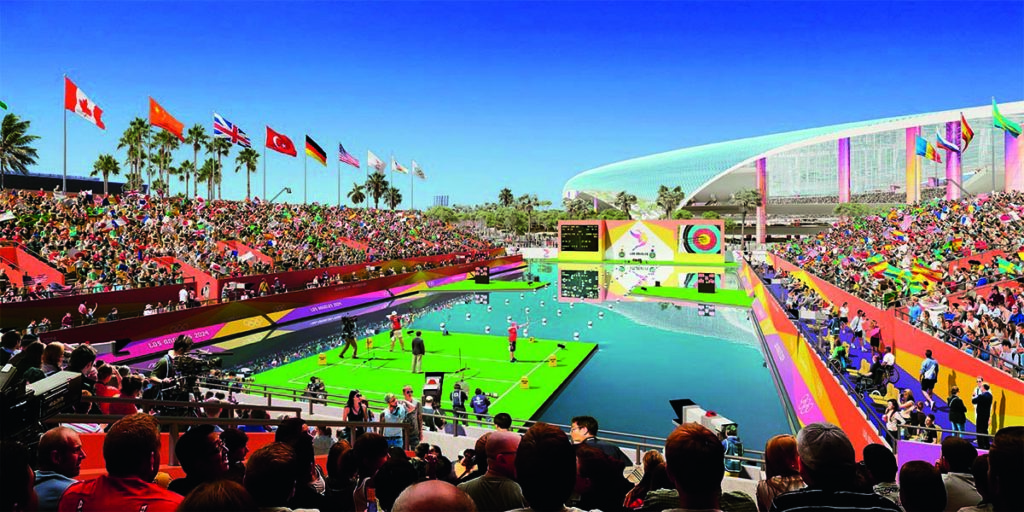Indications suggest programme will be same as Tokyo
Archery was confirmed as a core sport for the Los Angeles 2028 Olympic Games at the IOC’s 139th Session held in the Chinese capital Beijing, on the eve of the Winter Olympics. It will be the 15th Olympic outing for the sport since it returned to the Games in 1972. LA will become the third city to host the Games three times after London and Paris.
Good news, of course, but the sport programme is distinct from the event programme, which is not decided for certain yet and is subject to a multi-stage review. World Archery’s news article about the confirmation contained this caveat: “However, there is not expected to be a change from the five recurve competitions featured at Tokyo 2020 and set to remain in place for Paris 2024.”
This sentence seemed to confirm that the long-mooted introduction of compound archery to the Olympic Games would be delayed yet again. Bow contacted World Archery for more information, but was told that they couldn’t add anything to that statement “yet” and pointed out that the IOC review of the event programme was currently under way and the situation is not settled – and may not be for months or years.
However, the ‘managing expectations’ release of such a statement in advance does not bode well for those seeking to see compound archery become an Olympic sport in this decade.
Bow has spoken to World Archery secretary-general Tom Dielen more than once about the subject, most recently in Tokyo, and he explained the multiple issues involved. There are several large barriers to overcome – and it appears that some hurdles have got even larger recently.
The biggest is a mandated limit on the total number of athletes, which has been fixed at 10,500 for the Paris Games in 2024 and seems likely to be the same for LA. The measure, designed to reduce the costs of hosting, is now a keystone of Olympic policy.
The other major problem is universality. Olympic events – at least, new ones – have to be inclusive in the sense that the whole world should be able to be involved in some way. Compound archery remains popular in North America and Europe, with only small pockets of competitors, elite and recreational, spread unevenly around the rest of the world; this has long been a sticking point to getting compound added to the events list.
A key milestone has been reached: over the last Olympic cycle, World Archery has succeeded in getting compounds to the three major continental meets: the Pan American, European and Asian Games, and is hoping to add it to the lesser-known African and Pacific Games in the cycle leading up to Paris.
The compound field competition at the World Games in Birmingham, Alabama, due to be held this year, is expected to be the focus of the show and Olympic observers will be watching.
Another factor for getting a new Olympic event accepted is equality; having relatively equal numbers of men and women competing. There has been progress on this front, but not apparently enough yet. The IOC is also increasingly focused on sports that attract youth and youthful viewers; witness the introduction of skateboarding, surfing and sport climbing to the programme.
Many commentators have suggested that some kind of e-sports (computer gaming) will eventually head to the Olympics, possibly as soon as 2028. While compound archery is an event, rather than a new sport entirely, it’s certainly missing the sexy youth ‘wow’ factor that the IOC is hungry for at the moment.
Based on all this, it seems likely that while the slow, necessary milestones of progression towards compound becoming an Olympic sport are being reached, World Archery has decided that now may not the right time to propose it. (They have promised Bow a full update in due course.)
What would a compound Olympic archery competition look like?
Bow first looked at this in 2019. The athlete limit means that the chances of a compound competition on a similar scale to the recurve contest, with 128 athletes, is essentially zero.
If a compound competition did happen, it would now be more likely to feature the top 16 men and women in the world.
Standard 50m competition
This scenario would see the same Olympic archery venue reused for an increased number of days. The competition currently takes up the first week of an Olympics, now extended a further day for a mixed team event. With 32 athletes, individual events might take an extra one or two days.
Indoor competition in the shooting venue
Like archery, shooting takes place in the first week of a Games and the shooting venue, whether permanent or temporary, goes unused in the second week. This scenario would hold an indoor compound archery competition in the shooting venue at 18m, with a focus on absolute precision – and perhaps with a Vegas-style shootdown.
‘Urban field’ competition in the urban park
The urban park now plays host to sports such as 3×3 basketball, sport climbing and BMX freestyle. As you may imagine, events here are geared towards a younger audience. This would be a variation on a field competition in a structured ‘urban setting’. This scenario is currently the least explored or tested, but may provide the kind of broad youth appeal that the IOC is seeking for new events.


